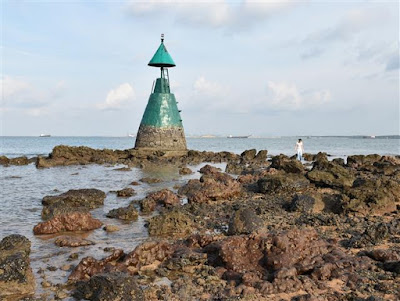This morning, we journeyed from the east (where most of our mainland shores are) to west to our last remaining mainland western reef at Tuas.
Much of the wonders of Tuas lies underwater in the slightly murky water which is part of the Straits of Johor. Unlike most shores in the north that are bound by this Straits, Tuas is home to lots of wonderful hard corals such as many types of Disk corals (Turbinaria sp.). Some are so huge that it is difficult to completely photograph the entire length using the camera.
I revisited this colony of Disk coral situated near the beacon and am dismayed to find that it is not doing very well.
Much of this coral have died off leaving the inner green polyps as the surviving ones.
This Boulder pore coral (Porites sp.) is so huge that I couldn't manage to take an entire photo using the camera without the photo being affected by the silt.
Outnumbering the hard corals are plenty of soft corals such as these Flowery soft corals (Family Nephtheidea) which are abundant underwater.
These pretty Orange lobed ascidians are sometimes seen on coral rubble. When submerged in water, it may expand into lobes or 'fingers' or mounds. Individual little zooids can be seen, each with a tiny hole, with a few, much larger holes among them.
The Purple branching sponges (Callyspongia sp.) are common on our northern shores and they look nice underwater!
What's Tuas without the variety of Sea fans (Order Gorgonacea)? They look very beautiful submerged underwater as the whole area looks like an underwater garden.
This sparsely branched brightly coloured sea fan looks different from the skinny and highly branched ones. I only came across one of this sea fan today.
The only flatworm I came across would be this Blue-spotted flatworm (Pseudoceros indicus) which I believe is feeding on the Yellow clustered bead ascidians (Eudistoma sp.).
There are many of these Sponge synaptid sea cucumber that are commonly found among sponges.
What's surprising would be that Sheryl found a large Cake sea star (Anthenea aspera) with two Sponge synaptid sea cucumbers on its aboral surface.
Here's a closer look at the synaptic sea cucumber on the surface of the sea star. Are they hitching a ride? Haha!
Though it was bright daylight, we were fortunate to see some of these Reef octopuses.
Among the colonies of these Starry leathery soft corals (Family Alcyoniidae), I totally missed this well camouflaged reef octopus until I process the photo at home. Can you spot it?
As the tide came in, we had a look at the higher sandy shores. I noticed that many of what looks like the Ball sea cucumbers (Phyllophorus sp.) but they look disfigured instead of the shape of a ball. This is puzzling.
It was good to see the Coastal horsehoe crab (Tachypleus gigas) and I noticed there are barnacles and even an anemone on its surface.
Here's a closer look at the anemone which didn't reveal its tentacles. I have not seen this anemone before.
What can we find at the seemingly boring rocky high shores? Flip the rocks gently and you will discover lots of life such as these Crown sea stars (Asterina coronata) which are also aptly known as the rock stars.
We also managed to find the Cryptic sea stars (Cryptasterina sp.). These sea stars are not commonly found on our rocky shores (or we didn't look hard enough) and we are glad that they are found in Tuas.
At the background of the shores of Tuas would be the coastal reclamation of Johor.
We believe that it is part of the construction to build Forest City just right across the shoreline of Tuas near the 2nd link. Let's hope that all these coastal development will not cause a significant impact the natural environment around the area.
More photos of the trip on my facebook album:
https://www.facebook.com/media/set/?set=a.10153419536998158.1073741883.547198157&type=1&l=1f32c512a1





























No comments:
Post a Comment